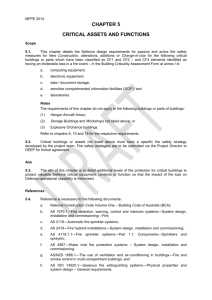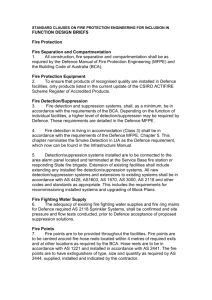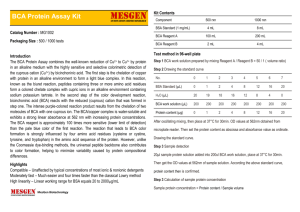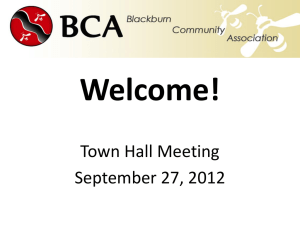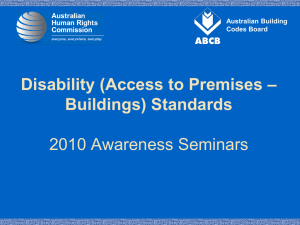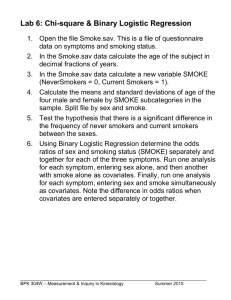Chapter 15
advertisement
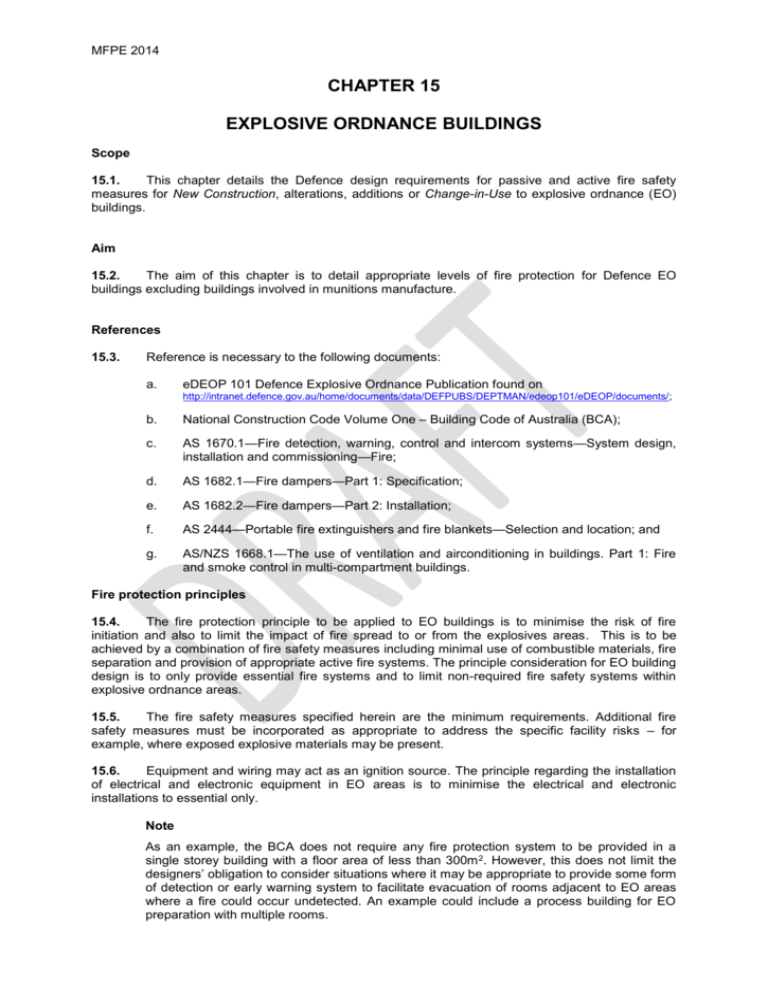
MFPE 2014 CHAPTER 15 EXPLOSIVE ORDNANCE BUILDINGS Scope 15.1. This chapter details the Defence design requirements for passive and active fire safety measures for New Construction, alterations, additions or Change-in-Use to explosive ordnance (EO) buildings. Aim 15.2. The aim of this chapter is to detail appropriate levels of fire protection for Defence EO buildings excluding buildings involved in munitions manufacture. References 15.3. Reference is necessary to the following documents: a. eDEOP 101 Defence Explosive Ordnance Publication found on http://intranet.defence.gov.au/home/documents/data/DEFPUBS/DEPTMAN/edeop101/eDEOP/documents/; b. National Construction Code Volume One – Building Code of Australia (BCA); c. AS 1670.1—Fire detection, warning, control and intercom systems—System design, installation and commissioning—Fire; d. AS 1682.1—Fire dampers—Part 1: Specification; e. AS 1682.2—Fire dampers—Part 2: Installation; f. AS 2444—Portable fire extinguishers and fire blankets—Selection and location; and g. AS/NZS 1668.1—The use of ventilation and airconditioning in buildings. Part 1: Fire and smoke control in multi-compartment buildings. Fire protection principles 15.4. The fire protection principle to be applied to EO buildings is to minimise the risk of fire initiation and also to limit the impact of fire spread to or from the explosives areas. This is to be achieved by a combination of fire safety measures including minimal use of combustible materials, fire separation and provision of appropriate active fire systems. The principle consideration for EO building design is to only provide essential fire systems and to limit non-required fire safety systems within explosive ordnance areas. 15.5. The fire safety measures specified herein are the minimum requirements. Additional fire safety measures must be incorporated as appropriate to address the specific facility risks – for example, where exposed explosive materials may be present. 15.6. Equipment and wiring may act as an ignition source. The principle regarding the installation of electrical and electronic equipment in EO areas is to minimise the electrical and electronic installations to essential only. Note As an example, the BCA does not require any fire protection system to be provided in a single storey building with a floor area of less than 300m 2. However, this does not limit the designers’ obligation to consider situations where it may be appropriate to provide some form of detection or early warning system to facilitate evacuation of rooms adjacent to EO areas where a fire could occur undetected. An example could include a process building for EO preparation with multiple rooms. MFPE 2014 15-2 PASSIVE FIRE PROTECTION Construction and separation 15.7. External walls and structural elements of EO buildings must be of non-combustible construction. For the purpose of this requirement, non-combustible is as defined in the BCA. Further requirements for bushfire prone areas are provided in chapter 7. Additional fire safety measures must be incorporated as appropriate to address the specific facility risks when exposed explosive materials are present. 15.8. The following rooms / areas within EO buildings shall be fire and smoke separated from the remainder of the building in accordance with paragraph 15.9: 15.9. a. All EO from non-EO areas; b. All Groups G and H – as defined in eDEOP 101; c. a Small Quantity room – as defined in eDEOP 101; and d. a plantroom containing an electrical supply switchboard and / or mechanical plant. Where fire and smoke separation is required, it shall be constructed as follows: a. internal fire walls providing fire separation shall be constructed of concrete or masonry, subject to compliance with eDEOP 101 explosion hazard design requirements. b. when required by the BCA, FRLs are to be in accordance with the BCA requirements – ie when needed as a fire wall. c. when required by this policy, but not required by the BCA, the FRL must be not less than 120/120/120. d. any doorway in that construction must be a self-closing -/120/30 fire door; e. any openings in external walls of fire separated areas must be separated and protected in accordance with clause C3.3 and C3.4 of the BCA; f. smoke separation in accordance with the method described in clause 2 of specification C2.5 and clause 3 of specification C3.4 of the BCA; and g. openings for services, penetrations, control joints and the like protected in accordance with clauses C3.12, C3.13 (for type A construction), C3.15 and C3.16 of the BCA. Notes (1) The above design requirements are to be considered equivalent to the separation requirements in the BCA between an electrical supply and the remainder of the building. Whilst not a BCA defined fire wall, additional requirements have also been included in relation to protection of openings in external walls and smoke separation. (2) Fire dampers and smoke dampers shall be installed in accordance with AS 1682 Parts 1 and 2, and AS/NZS 1668.1. (3) Operation or testing of fire and smoke dampers shall not cause any sparks. Where applicable, access panels associated with fire and smoke dampers shall be located outside the EO room. (4) Fire and smoke dampers can only be installed in the same manner for which the prototype has been fire tested. It is important that verification confirm the installation has been in accordance with this prototype testing as part of the building approval process. (5) Current fire test certificates shall be provided for all fire and smoke dampers installations as part of the building approval process. MFPE 2014 15-3 ACTIVE FIRE PROTECTION Fire detection 15.10. Fire detection and alarm systems shall be provided when required by the BCA. Additionally, detection and alarm systems should be installed when appropriate to provide some form of detection or early warning system to facilitate evacuation of EO areas where the intrinsic cues of a fire may not be readily apparent. When required they shall be installed in accordance with clause 4 of specification E2.2a of the BCA and AS 1670.1. 15.11. An air-handling system which supplies air into an EO area through a fire and smoke barrier – required under paragraph 15.8 shall: 15.12. a. incorporate smoke dampers where the air-handling ducts penetrate the fire walls; and b. be arranged such that the air-handling system is shut down and the smoke dampers are activated to close automatically by: (1) smoke detection on the non-EO side of the fire and smoke wall set out as per the occupied space requirements of clause 4.10(a) of AS/NZS 1668.1; (2) non-latching smoke detectors complying with clause 4.10(b) of AS/NZS 1668.1. Where a fire detection and alarm system is provided: a. the fire indicator panel (FIP) – including a manual call point – shall be located outside the building and be clearly visible and readily accessible adjacent to the designated building entry point (DBEP) or the fire control room as required by AS 1670.1; and a. the installation within the EO area must be designed and installed in accordance with the requirements of eDEOP 101 Regulation 6.3. Fire extinguishers 15.13. All EO areas within a building are to be considered as special hazards for the purposes of applying clauses E1.6 and E1.10 and table E1.6 of the BCA in relation to portable fire extinguishers. Fire hydrants and hose reels 15.14. Firefighting generally presents an unacceptable risk to on-site personnel and firefighters and as such having fire hydrants and hose reels in close proximity to or within EO buildings may not be appropriate. Therefore, fire hydrant and hose reels shall not normally be installed in or near EO buildings unless absolutely necessary and required – refer to paragraph 1.29 for requirements regarding consultation with responding firefighting services. The principle is that EO buildings be designed so that hydrant and hose reel systems are not required by the deemed-to-satisfy (DTS) provisions of the BCA – eg by limitation of fire compartment floor area. If proposed to be omitted when required by the BCA, then an alternative solution as outlined in chapter 2 is required. EO goods clearance 15.15. All EO goods shall be located a minimum of 3m from any fire and smoke barrier required under paragraph 15.8.
